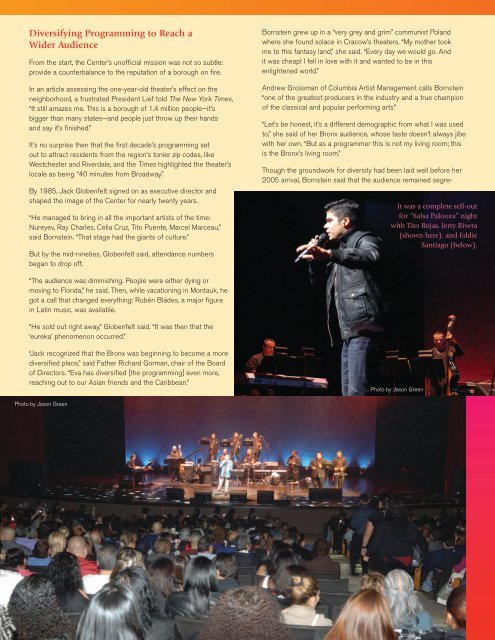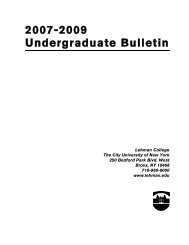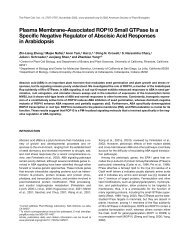Fall 2010 - Lehman College
Fall 2010 - Lehman College
Fall 2010 - Lehman College
You also want an ePaper? Increase the reach of your titles
YUMPU automatically turns print PDFs into web optimized ePapers that Google loves.
Diversifying Programming to Reach a<br />
Wider Audience<br />
From the start, the Center’s unofficial mission was not so subtle:<br />
provide a counterbalance to the reputation of a borough on fire.<br />
In an article assessing the one-year-old theater’s effect on the<br />
neighborhood, a frustrated President Lief told The New York Times,<br />
“It still amazes me. This is a borough of 1.4 million people—it’s<br />
bigger than many states—and people just throw up their hands<br />
and say it’s finished.”<br />
It’s no surprise then that the first decade’s programming set<br />
out to attract residents from the region’s tonier zip codes, like<br />
Westchester and Riverdale, and the Times highlighted the theater’s<br />
locale as being “40 minutes from Broadway.”<br />
By 1985, Jack Globenfelt signed on as executive director and<br />
shaped the image of the Center for nearly twenty years.<br />
“He managed to bring in all the important artists of the time:<br />
Nureyev, Ray Charles, Celia Cruz, Tito Puente, Marcel Marceau,”<br />
said Bornstein. “That stage had the giants of culture.”<br />
But by the mid-nineties, Globenfelt said, attendance numbers<br />
began to drop off.<br />
Bornstein grew up in a “very grey and grim” communist Poland<br />
where she found solace in Cracow’s theaters. “My mother took<br />
me to this fantasy land,” she said. “Every day we would go. And<br />
it was cheap! I fell in love with it and wanted to be in this<br />
enlightened world.”<br />
Andrew Grossman of Columbia Artist Management calls Bornstein<br />
“one of the greatest producers in the industry and a true champion<br />
of the classical and popular performing arts.”<br />
“Let’s be honest, it’s a different demographic from what I was used<br />
to,” she said of her Bronx audience, whose taste doesn’t always jibe<br />
with her own. “But as a programmer this is not my living room; this<br />
is the Bronx’s living room.”<br />
Though the groundwork for diversity had been laid well before her<br />
2005 arrival, Bornstein said that the audience remained segre-<br />
It was a complete sell-out<br />
for “Salsa Palooza” night<br />
with Tito Rojas, Jerry Rivera<br />
(shown here), and Eddie<br />
Santiago (below).<br />
“The audience was diminishing. People were either dying or<br />
moving to Florida,” he said. Then, while vacationing in Montauk, he<br />
got a call that changed everything: Rubén Bládes, a major figure<br />
in Latin music, was available.<br />
“He sold out right away,” Globenfelt said. “It was then that the<br />
‘eureka’ phenomenon occurred.”<br />
“Jack recognized that the Bronx was beginning to become a more<br />
diversified place,” said Father Richard Gorman, chair of the Board<br />
of Directors. “Eva has diversified [the programming] even more,<br />
reaching out to our Asian friends and the Caribbean.”<br />
Photo by Jason Green<br />
Photo by Jason Green<br />
14 <strong>Lehman</strong> Today/<strong>Fall</strong> <strong>2010</strong> – Winter 2011

















